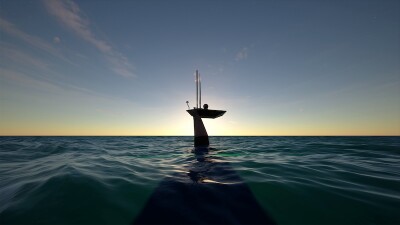In October, David Evans and Associates Inc.’s Marine Services Division commissioned its new, customized 82' hydrographic survey vessel in Gulfport, Miss. The Blake was built at Geo Shipyard, New Iberia, La.
The 82'×27'×10'3" survey vessel for DEA has a 4'4" draft. It features a hydraulic DTI survey winch with 2,000 meters of cable and a hydraulic side-scan stainless-steel survey strut with a moon pool; a bow crane for side scans in shallow water; a crane for AUV deployment; a 3,000-lb-capacity A-frame with two PL2 winches for towing astern; a moving vessel profiler capable of taking a cast to 350 meters; an Odom CV300 with dual 200-kHz transducers; and 100-kHz and 12-kHz narrow transducers.
The aluminum catamaran also features wave-piercing bows. It is powered by Caterpillar C18 Tier 3 diesels each producing 803 hp at 2,100 rpm. The Cats turn ZF 36"×44" nibral 4-bladed propellers through ZF 500A gears with 2.48:1 ratios. The propulsion package gives the Blake a top speed of 25 knots, a 20-knot cruise speed and a survey speed of 7 knots. The vessel is also outfitted with a pair of Wesmar 23-hp bowthrusters. Twin Northern Lights 55-kW generators provide service power.
The Blake can accommodate a crew of four and 20 passengers. The vessel can sleep 10 for offshore service for up to 10 days in five staterooms with three heads.
Geo co-owner David LeCompte said one difference between the Blake and the 60' survey vessels Redlinger and Elton the yard built for the Corps of Engineers Portland (Ore.) District in 2010 (besides the boats’ different survey capabilities) was that the Corps boats had an electric strut with a moon pool. The Blake’s is hydraulic and also made of stainless steel. The Blake also has displacement hulls and the Corps boats have HysuCraft hulls, LeCompte said.
Jon Dasler, DEA’s director of marine services, said the company looked at the Corps survey boats Geo built and liked what they saw. It made their choice of builder much easier.
The Blake is under a five-year contract to the National Oceanic and Atmospheric Association to provide critical hydrographic data for updating the nation’s nautical charts. The boat will begin its career in the Gulf of Mexico performing charting surveys of Gulfport Channel and Chandeleur Sound with 24-hour survey operations and port calls every 10 days.
Over the last 15 years, NOAA has awarded more than $400 million to private survey companies under the Office of Coast Survey’s hydrographic contracting program. “David Evans and Associates consistently produces outstanding hydrographic surveys for NOAA,” Rear Adm. Gerd Glang, director of NOAA’s Office of Coast Survey, said at the commissioning. “And they are pioneers in applying new surveying technologies and methods.”
The vessel will operate out of Gulfport and will complement Vancouver, Wash.-based DEA’s national operations and expand the company’s hydrographic and geophysical survey capabilities in the Gulf of Mexico and elsewhere.
Geo is also busy with a $2.3 million research, academic and training vessel for Texas A&M University at Galveston. The 64'9"×21'6"×9'3" Trident will have a cruising speed of 17 knots and be equipped with standard sampling gear. It will have berths for 12 crew and scientists and will operate 24 hours a day for up to five days in between port calls. It will have a large 400-sq.-ft. working deck and a 240-sq.-ft. lab. Delivery is scheduled for May 2015.
— David Krapf




